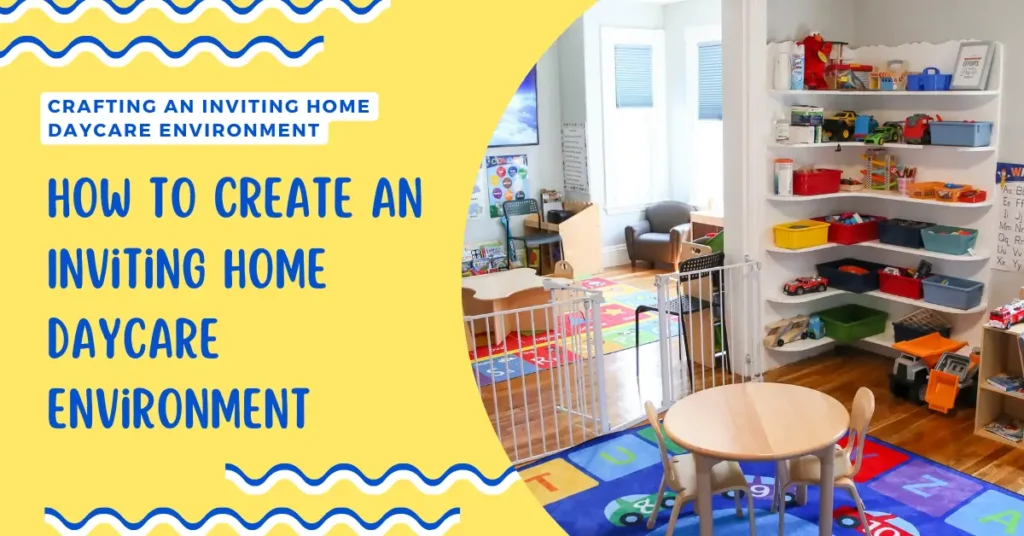Embarking on establishing a home daycare is not just about starting a business; it’s about creating a second home where children feel safe, loved, and stimulated to learn and grow. As the foundation of early childhood development, the environment we provide plays a pivotal role in shaping young minds and hearts. In this comprehensive guide, we will delve into the intricacies of setting up a home daycare that meets the standard requirements and goes above and beyond to offer a warm, engaging, and enriching atmosphere for the little ones in your care.
The environment of home daycare setup is a meticulous process that involves thoughtful consideration of space layout, educational materials, safety measures, and the emotional ambiance. It’s about striking the perfect balance between a structured learning setting and a cozy, nurturing home space that children are excited to be a part of each day.
Engaging children in a space that combines comfort with elements of discovery and learning is essential for their cognitive and emotional development.
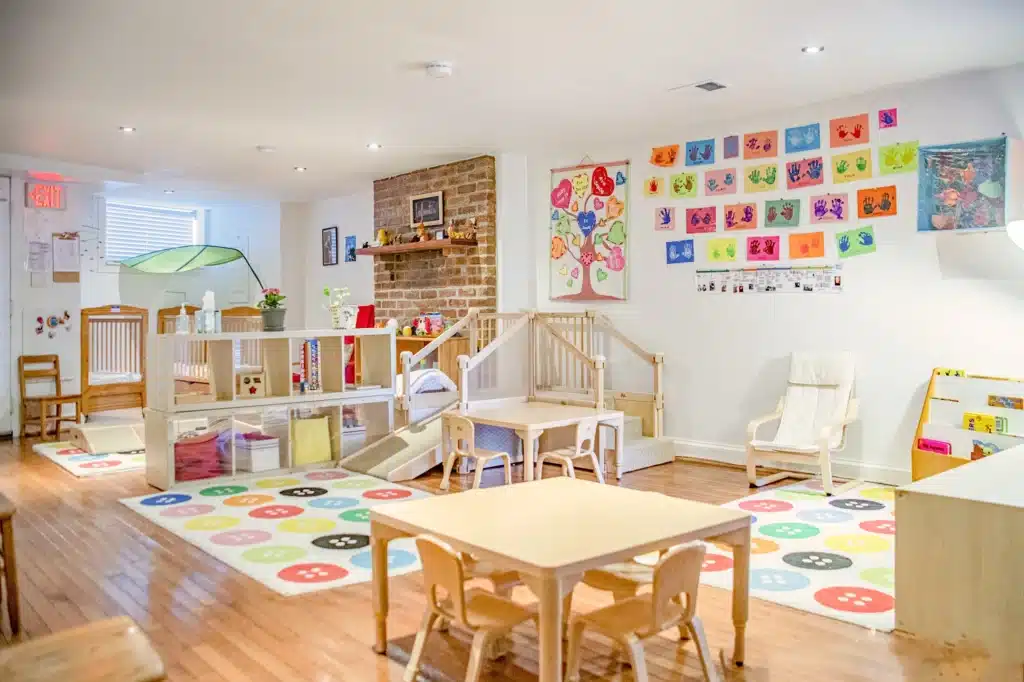
Understand the Basics of Home Daycare Setup
Home daycare setup involves more than just providing a space for children to stay while their parents are at work. It requires a deep understanding of child development, educational methodologies, business management, and legal requirements. To build a successful home daycare setup, one must consider several key aspects:
Licensing and Regulations: Each country or region has specific regulations for home daycares, which may include licensing requirements, safety inspections, and operational guidelines. Understanding these regulations is crucial to ensure your daycare is compliant and can operate legally. Licensing typically involves background checks, home inspections, and first aid and child care training.
Child Development Knowledge: Understanding the stages of child development is essential to create an environment that supports the physical, emotional, intellectual, and social growth of children. Home daycare setup providers should be knowledgeable about age-appropriate activities, toys, and educational materials to stimulate development and meet the diverse needs of children in their care.
Safety and Health Standards: A safe environment is paramount in a home daycare setup. This includes not only childproofing the premises and ensuring the safety of toys and equipment but also maintaining cleanliness and hygiene to prevent the spread of illnesses. Regular safety audits and risk assessments can help identify potential hazards and implement necessary preventative measures.
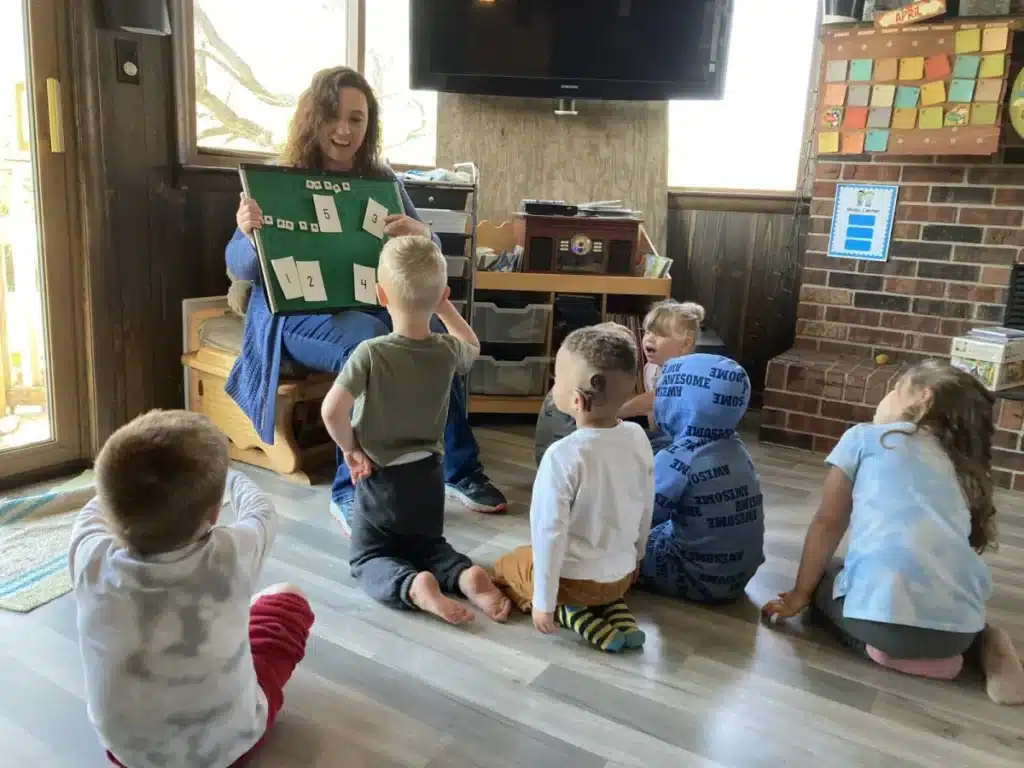
Curriculum and Program Development: Home daycare might not follow a formal curriculum like larger childcare centers, but having a structured daily program with a balance of educational, physical, and free play activities is important. This should foster learning and development while keeping the children engaged and entertained.
Nutritional Planning: Providing healthy, balanced meals and snacks is another crucial aspect of running a home daycare setup. Nutritional planning should consider each child’s dietary needs and restrictions, ensuring that meals are healthy, varied, and appealing to young palates.
Business Management Skills: A home daycare setup runs a small business. This requires basic business management skills, including financial planning, budgeting, record-keeping, and marketing. Understanding how to manage the operational aspects of the daycare will contribute to its success and sustainability.
Communication Skills: Effective communication with parents, children, and staff is vital. Building strong relationships with parents through open, transparent communication can lead to better understanding and cooperation. Regular updates, meetings, and feedback sessions can help maintain trust and ensure that the care provided aligns with the expectations and needs of the families.
Creating a Nurturing Environment: Beyond the physical space, creating a nurturing environment involves fostering a sense of security, belonging, and wellbeing among the children. This includes having a caring, responsive approach to child care where each child feels valued and supported.
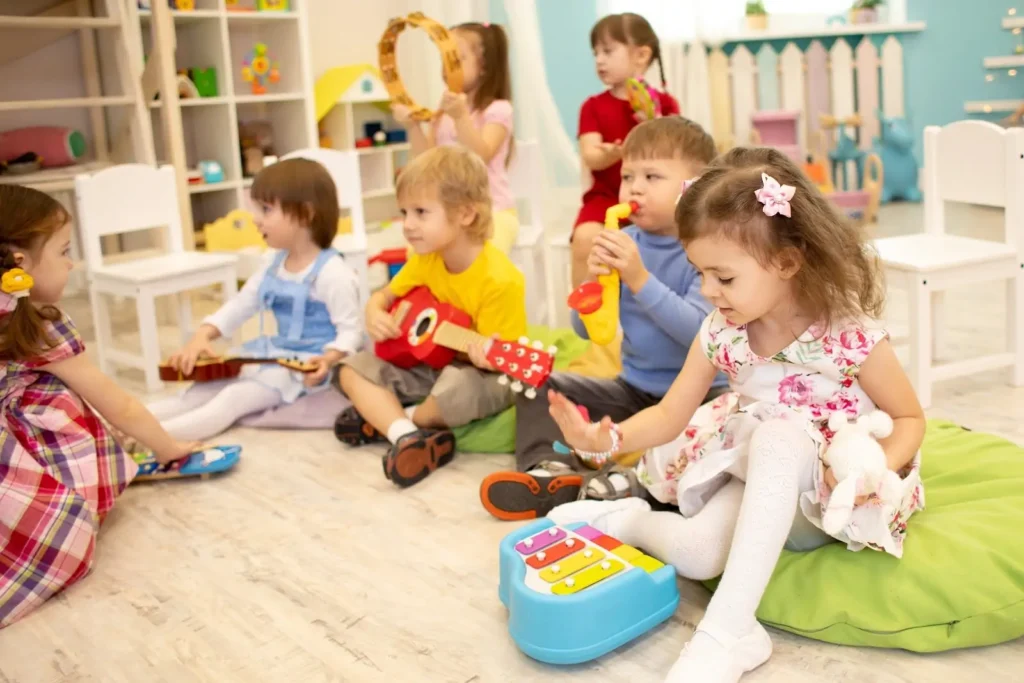
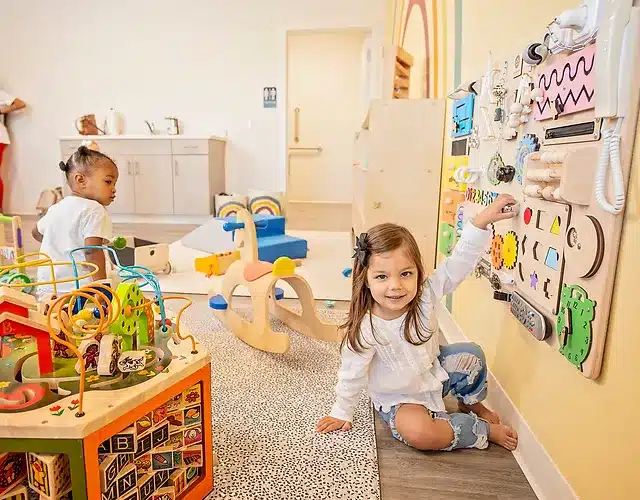
Creating an Inviting Home Daycare Setup
Transforming a home into an inviting daycare environment requires a blend of creativity, strategy, and attention to detail. It’s about crafting a space that meets children’s physical and safety needs and nurtures their emotional and intellectual growth. Here, we explore essential steps to create a welcoming and stimulating home daycare setting.
Firstly, the atmosphere of the home daycare setup should spark joy and curiosity in young minds. Achieving this involves more than just having an array of toys; it’s about creating diverse learning zones. These zones can include a quiet reading nook filled with books on low shelves accessible to children, a creative corner for arts and crafts with materials safely within reach, and an area dedicated to imaginative play with costumes and props that encourage role-playing.
A key aspect is the use of color and texture throughout the daycare. Soft, calming colors can soothe and help maintain a peaceful environment, while bright accents stimulate interest and engagement. Incorporating a variety of textures through rugs, pillows, and curtains adds to the sensory experience, making the space more inviting and comfortable.
Natural elements play a significant role in making a space feel welcoming. Indoor plants, wooden toys, and natural light beautify the environment and create a healthy indoor atmosphere. Plants can improve air quality, while natural light boosts mood and productivity, benefiting children and caregivers.
Safety and accessibility are paramount. Furniture should be sturdy and rounded at the edges, electrical outlets covered, and non-toxic materials used wherever possible. Everything a child needs should be easily accessible, fostering independence and self-confidence. This includes making sure that play materials are stored at the child’s height and that personal belongings have a specific place that children can reach.
Incorporating family and community into the daycare creates a profound sense of belonging. This can be achieved through a photo wall of the children with their families; artwork displays that include contributions from every child, and a welcoming area where parents can spend a few moments settling their child into the day.
Flexibility in the environment is also crucial. Spaces should be adaptable to various activities and easily changeable according to the day’s needs or as children’s interests evolve. Modular furniture and multipurpose play mats or rugs can facilitate this flexibility, allowing quick transitions between activities without major disruptions.
Creating an inviting home daycare setup environment is a thoughtful process that combines safety, educational opportunities, and a home-like warmth. It’s about setting the stage for children to explore, learn, and grow in an atmosphere that feels both exciting and secure.
How can you ensure safety while maintaining a home-like feel?
Safety and a home-like feel are not mutually exclusive; they complement each other. Creating a safe environment that still feels like home involves meticulous planning and attention to detail. It starts with adhering to safety regulations and guidelines for home daycare setup but incorporates those elements into a warm and inviting design.
For a detailed expansion, consider the following elements:
- Physical Layout and Design: How to arrange the space to minimize accidents while promoting a cozy, inclusive atmosphere.
- Materials and Equipment: Choosing child-friendly furniture and toys that ensure safety without compromising the homely aesthetic.
- Safety Protocols: Implementing safety measures seamlessly blending into the daily routine, making safety a natural part of the children’s environment.
- Engagement and Learning: Balancing educational materials and activities with elements that reflect a home-like environment, such as kitchen play sets or dress-up corners.
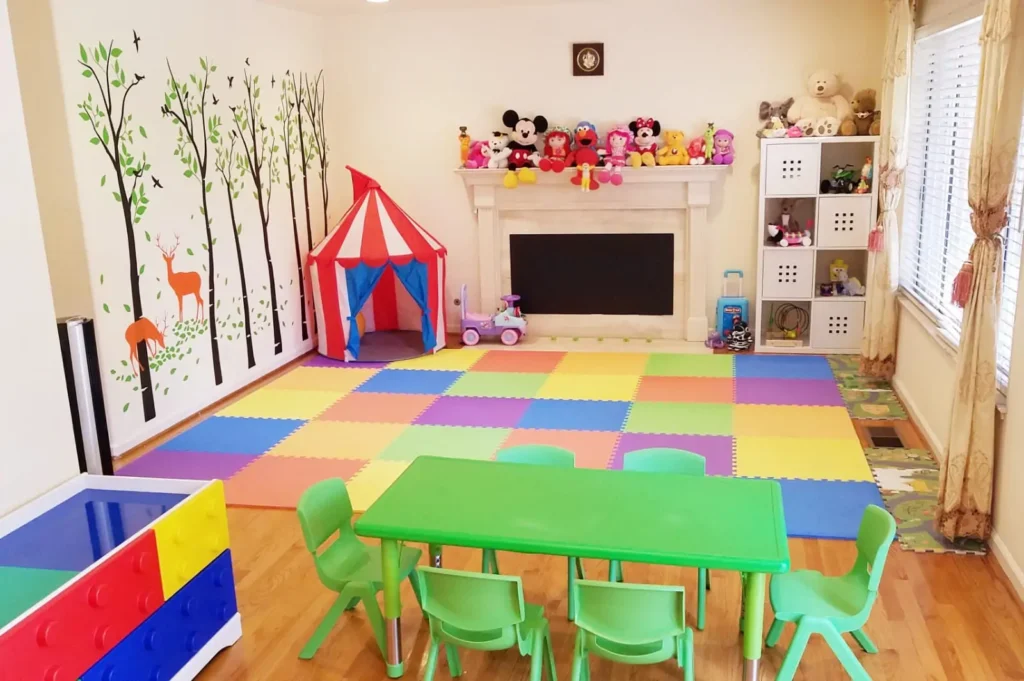
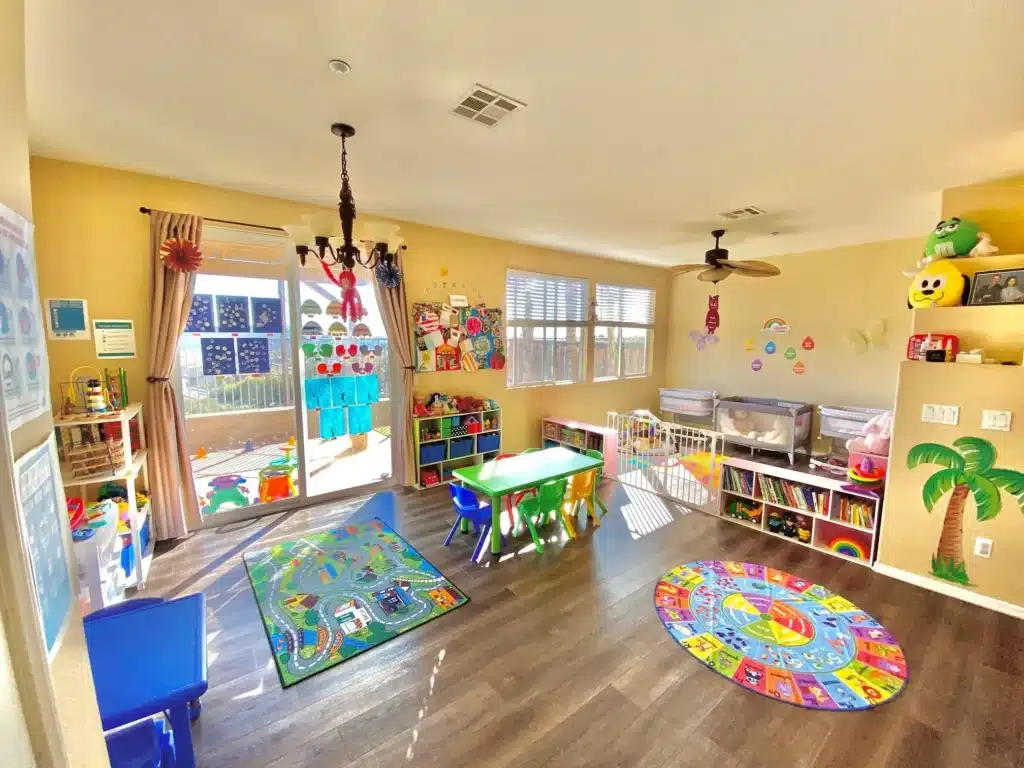
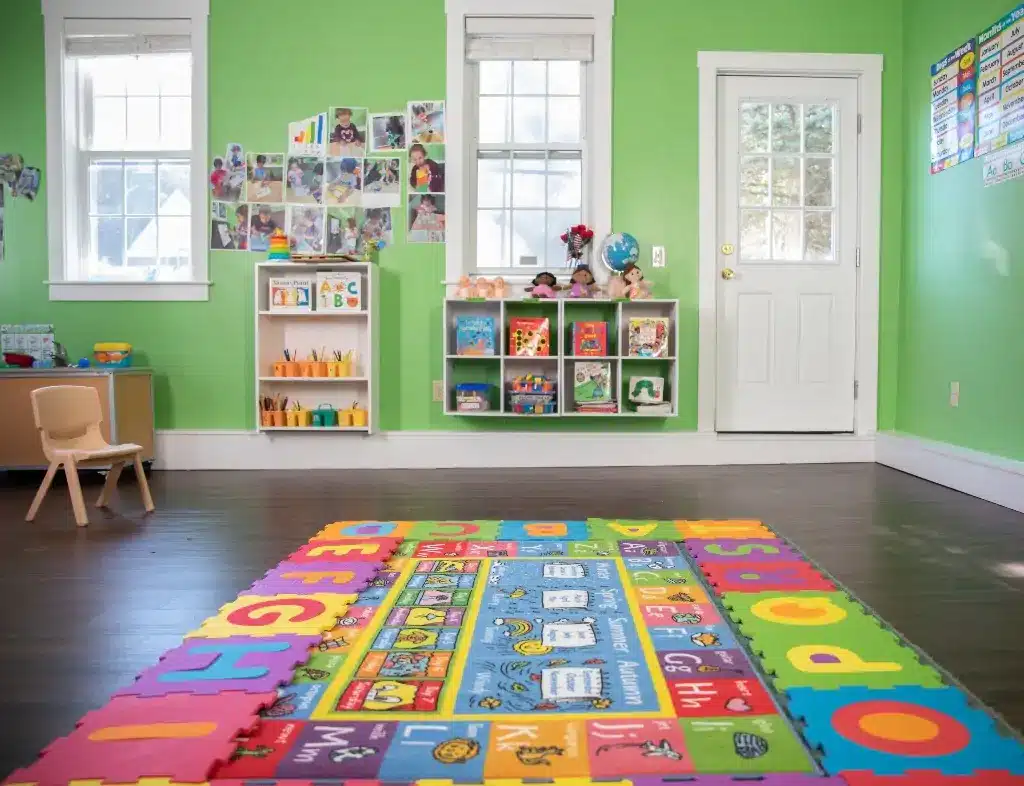
What are the key elements of a child-friendly space?
Creating a child-friendly space, particularly in a home daycare setup, requires thoughtful consideration of several factors that contribute to a safe, engaging, and inclusive environment. Here’s an expanded structure with detailed subtopics:
Safety First
- Detailed guidelines on child-proofing the space, covering electrical outlets, furniture edges, and potential choking hazards.
- Discuss the importance of non-toxic materials in everything from paint to play mats.
Sensory Development
- How different textures, sounds, and visuals can stimulate learning.
- Creating zones within the daycare that cater to different senses, e.g., a music corner, a visual arts area, and a tactile exploration zone.
Active Play vs. Quiet Spaces
- Designing areas dedicated to physical activity, such as a mini obstacle course or a dance space, and why they’re important for motor skills development.
- Equally, crafting quiet areas for reading and downtime, focusing on the importance of balance between activity and rest.
Inclusivity and Diversity
- Ensuring toys, books, and decorations reflect various cultures and family structures.
- Strategies for creating an environment welcoming for children with different needs and abilities.
Flexibility and Adaptability
- It is important to have versatile furniture and play equipment to keep the environment dynamic and responsive to children’s changing interests.
- Case studies or examples of multi-use items and how they can be incorporated into daily activities.
Engagement and Learning
- How to select toys and materials that not only entertain but also educate.
- The role of technology in learning, including recommendations for age-appropriate digital tools and guidelines for screen time.
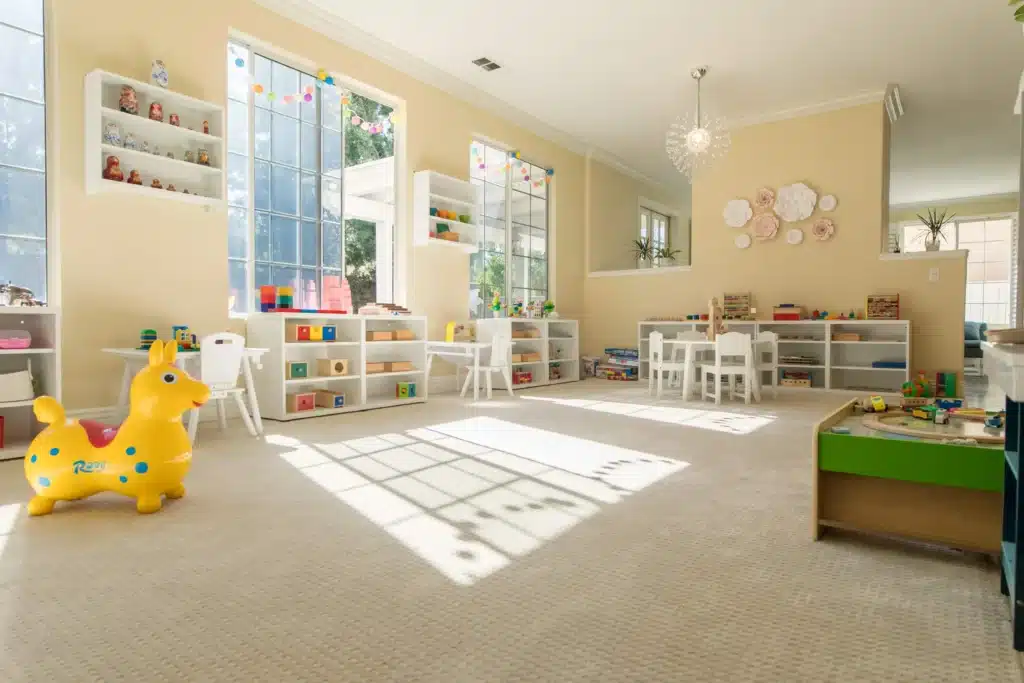
How do you choose the right furniture and equipment?
Choosing the right furniture and equipment for a home daycare setup is critical to creating a safe environment that is engaging and conducive to learning. The selection should align with the developmental needs of children while also considering safety standards and durability.
Start by focusing on safety and durability. Furniture should be sturdy, have no sharp edges, and be made from non-toxic materials. Look for certifications or endorsements from recognized safety organizations. Equipment like shelves and tables should have rounded corners, and all furniture should be appropriately sized for children to use independently without risk of injury.
Consider the versatility and flexibility of the furniture. Choose items that can serve multiple purposes or be reconfigured for various activities. Adjustable tables that can be used for art projects, meals, and learning activities or storage units with bins that can be rearranged based on the day’s needs are great examples.
The aesthetics of the furniture and equipment also play a role in creating an inviting and stimulating environment. Select items that are colorful and appealing to children but avoid overstimulation. A balance between vibrant and calming colors is ideal, with natural wood tones often serving as a neutral base that can be accented with colorful accessories and decorations.
Inclusion and accessibility are paramount. Ensure that the space and furnishings are accessible to all children, including those with special needs. This might mean selecting furniture with adjustable heights, providing various types of seating that accommodate different physical needs, and ensuring that all daycare areas are easily navigable for children with mobility challenges.
Finally, sustainability is an important consideration. Opt for furniture and equipment made from sustainable materials that are easy to clean and maintain. This supports environmental responsibility and ensures that the items will withstand the rigors of daily use in a daycare setting.
Selecting the right furniture and equipment for a home daycare setup involves carefully balancing safety, functionality, and aesthetic appeal. Focusing on these key aspects can create a child-friendly environment that supports learning, development, and play.

How to Create an Educational Yet Playful Atmosphere in Home Daycare Setup
Creating an educational yet playful atmosphere in a home daycare setup involves a strategic blend of environments, activities, and methodologies that foster learning while ensuring the experience remains joyous and engaging for children. For a comprehensive exploration, let’s dive into practical strategies and examples, focusing on simplicity and real-world application without repetition to foster a nurturing and stimulating setting.
Cultivating a Learning Environment Through Play
The Foundation: Understanding Educational Play
Educational play merges the joy of play with the benefits of learning, engaging children in activities that stimulate their curiosity and encourage exploration. It’s grounded in the principle that children learn best when actively involved and enjoying themselves.
Key Components of an Educational Play Area
- Safety and Accessibility: The area must be safe and accessible, with furniture and toys suited to the children’s age and abilities. This ensures they can explore freely without risk.
- Variety and Flexibility: A range of activities catering to different interests and developmental stages is crucial. Flexibility in the setup allows for changes based on the children’s evolving interests.
Strategies for Integrating Education into Play
- Themed Play Zones: Create distinct areas in your daycare that each focus on a different aspect of learning. For instance, a reading nook encourages literary skills, while a puzzle corner can enhance cognitive development.
- Daily Discovery Themes: Implement a rotating theme schedule covering various educational topics. This could range from nature and the environment one week to space exploration the next, providing diverse learning opportunities.
Choosing the Right Tools for Engagement
Selecting Educational Toys and Resources
- Multi-sensory Toys: Opt for toys that engage multiple senses, enhancing learning by providing children with a more holistic experience. Items emitting sounds, having different textures, or requiring physical interaction are ideal.
- Problem-solving Games: Games that challenge children to think critically and solve problems support cognitive development and can be introduced during playtime to blend learning with fun.
The Role of Technology in Educational Play
- Digitally Enhanced Learning: While traditional play is invaluable, incorporating technology like educational apps or interactive games can offer a fresh dimension to learning, especially for concepts that benefit from visual or auditory representation.
- Guided Tech Time: It’s essential to supervise and limit the use of technology, ensuring it complements physical play rather than replacing it. Structured tech activities can make learning new skills exciting and interactive.
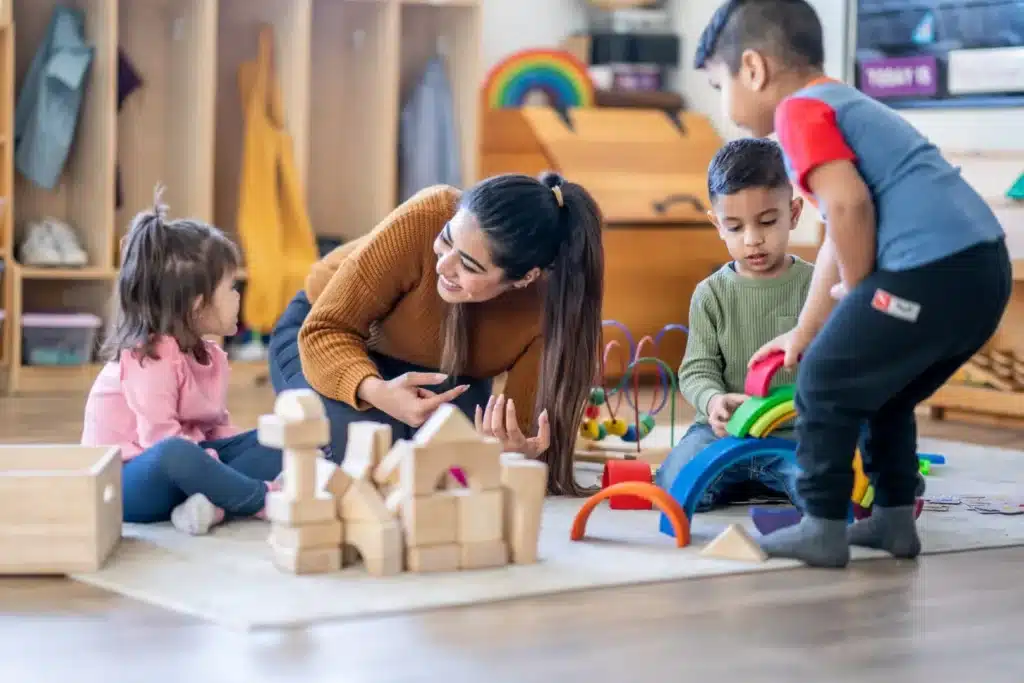
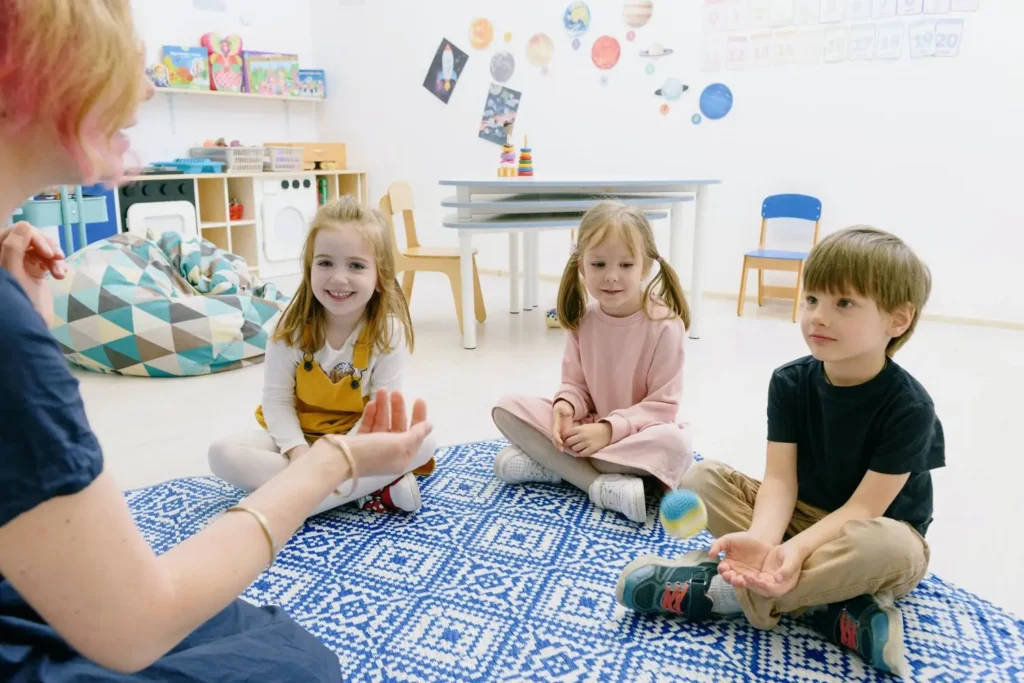
Enriching the Daycare Atmosphere
Integrating Arts and Crafts
- Creative Projects: Arts and crafts not only allow for creative expression but can also be used to reinforce concepts from other learning areas. For instance, drawing activities tied to a science theme like plant life cycles.
- Collaborative Artwork: Working on group art projects can teach teamwork and cooperation alongside fostering a sense of community within the daycare.
Embracing Outdoor Learning
- Nature as a Classroom: Outdoor play is not just for physical health; it can also be a rich learning environment. Simple activities like observing the weather, planting a garden, or exploring the properties of water can teach scientific principles in a hands-on manner.
- Structured Outdoor Games: Games that involve rules and teamwork can introduce concepts of fairness, strategy, and mathematical thinking in a natural, enjoyable setting.
Encouraging Reading and Storytelling
- A Library Corner: A cozy corner with a selection of books invites children to explore stories and concepts at their own pace, fostering a love for reading.
- Storytelling Sessions: Regular storytelling can enhance listening skills, expand vocabulary, and introduce narrative understanding in an engaging format.
Social Skills and Emotional Development
- Role-playing and Drama: Role-play activities help children understand different perspectives and develop empathy. They also offer opportunities to practice communication and social interaction.
- Emotion-Sharing Circles: A daily or weekly session where children can share experiences or feelings promotes emotional intelligence and creates a supportive community atmosphere.
By focusing on these areas and continuously adapting to the needs and interests of the children in your care, you can create a dynamic home daycare setup that marries education with play effectively. This balance ensures that children are prepared academically and happy, confident, and well-rounded.
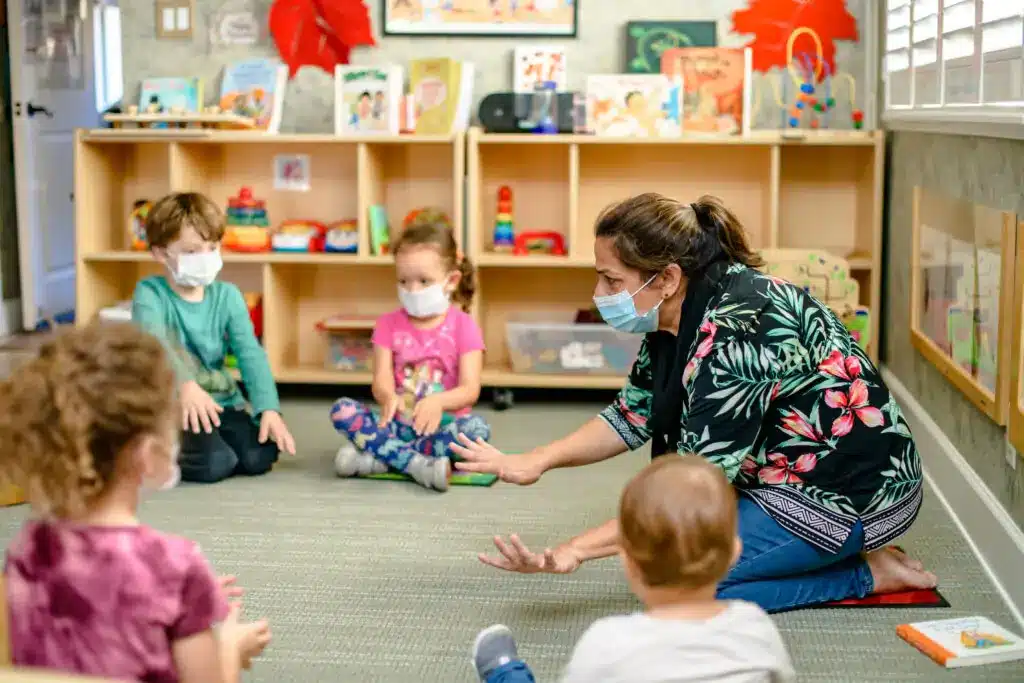
What Role Does Outdoor Space Play in Your Home Daycare Setup?
In my home daycare setup, the outdoor space is not just an extension of our indoor environment; it’s a vibrant, essential part of our daily routine and learning experience. The benefits of incorporating outdoor time are vast, contributing significantly to children’s physical health, emotional well-being, and developmental milestones.
- A Natural Classroom for Exploration and Learning: Our outdoor space serves as a natural classroom, offering endless opportunities for exploration and discovery. Here, children learn about the world around them firsthand. From observing the lifecycle of plants and insects to understanding the principles of physics through play, the outdoors makes learning tangible and engaging. Educational concepts, especially in science and environmental awareness, are naturally woven into outdoor activities, making them accessible and enjoyable for children.
- Physical Health and Development: Physical activity is crucial for growing children, and our outdoor space is designed to promote this. Children develop gross motor skills, coordination, and balance with equipment like swings, slides, and climbing frames. These activities also contribute to their overall health, reducing the risk of obesity and promoting cardiovascular fitness. Regular outdoor play ensures that children are physically active, essential for healthy growth and development.
- Social Skills and Cooperation: Outdoor play is often more unstructured than indoor activities, allowing children to initiate games and interactions. This environment fosters social skills as children learn to negotiate, share, and work together to solve problems or create games. The outdoor space in our home daycare setup is a communal area where children learn the value of teamwork and develop friendships, playing a critical role in their social and emotional development.
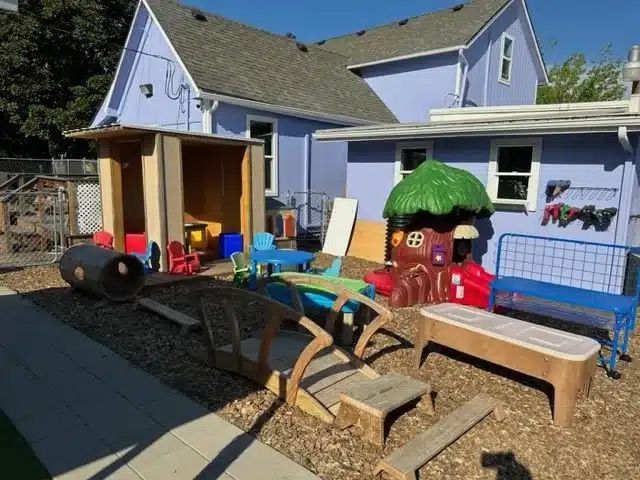
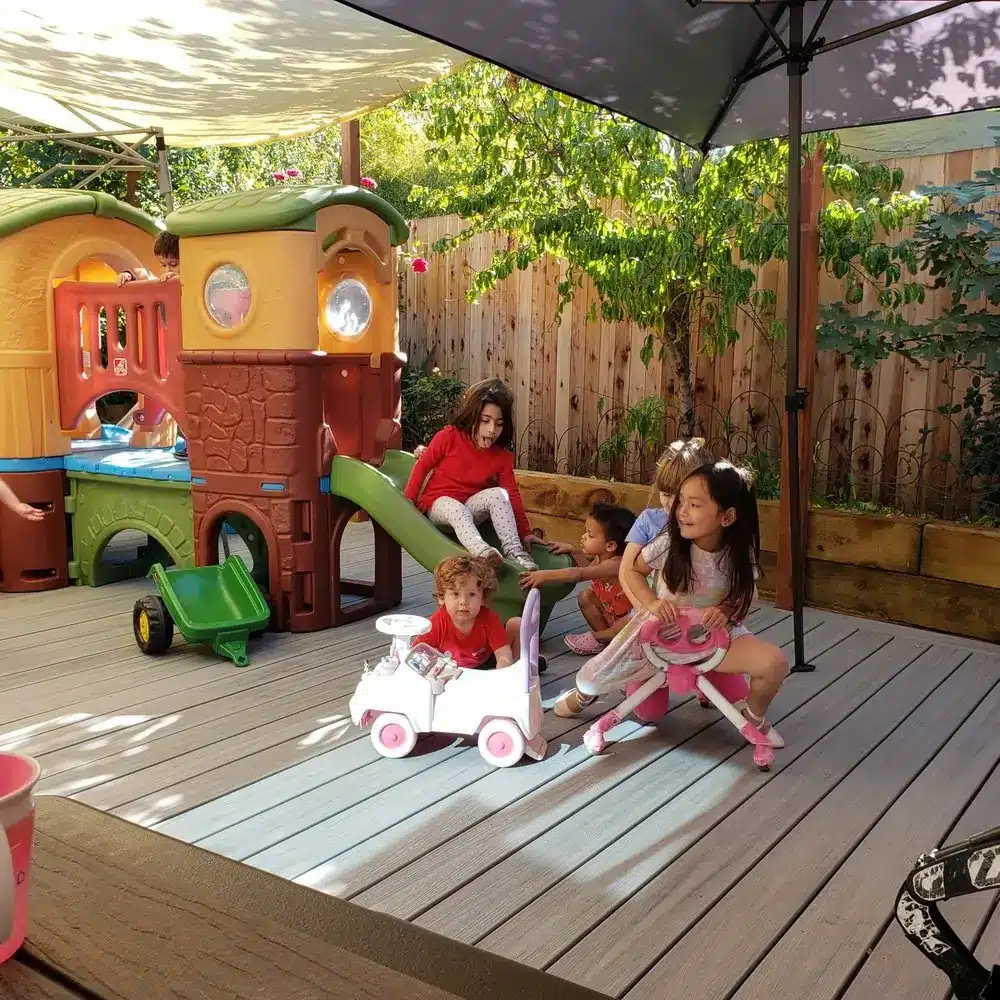
- Emotional Well-being and Stress Reduction: The outdoor space offers a unique therapeutic value, contributing significantly to children’s emotional well-being. Natural settings have been shown to reduce stress and help children feel more relaxed and happy. In our home daycare setup, time spent outdoors allows children to ‘reset’ if they’re feeling overwhelmed or frustrated. The sensory experiences nature provides—such as the feeling of grass underfoot, the sound of leaves rustling, and the sight of butterflies—help soothe and calm their minds.
- Encouraging Creativity and Imagination: Outdoor environments stimulate children’s imagination in ways that indoor spaces may not. Children invent games, create imaginary worlds, and adventure with the sky as their backdrop. Our home daycare setup uses the outdoor space to encourage this imaginative play, which is crucial for cognitive development. It allows children to express themselves creatively, think outside the box, and explore different aspects of their personalities.
- Independence and Risk-Taking: In the safety of our monitored outdoor area, children are encouraged to take small, manageable risks. This could mean climbing higher on the jungle gym or trying out a new slide. These experiences are vital for building self-confidence and resilience. By navigating these challenges, children in our home daycare setup learn to assess risks, make decisions, and develop a sense of independence.
The outdoor space at our home daycare setup is far more than just a place to run off energy. It’s a fundamental part of our learning environment, contributing to the children’s physical, social, emotional, and cognitive development. It’s where they learn about nature, themselves, and each other. Ensuring that children have quality time outdoors is our priority, reflecting our commitment to providing a holistic, nurturing, and balanced approach to early childhood education.
Creating an inviting home daycare setup is much like nurturing a garden; it requires patience, care, and a keen eye for what makes a space flourish. Every detail contributes to a setting where children feel safe, valued, and eager to explore, from the cozy reading corners to the laughter-filled play areas. It’s about blending the comforts of home with the adventures of learning, making your home daycare a place where young imaginations can soar.
As we wrap up, it’s clear that the essence of an inviting home daycare setup lies in its ability to foster a sense of community and joy. It’s a place where every toy, book, and piece of furniture is chosen to enrich children’s lives, supporting their growth and sparking their curiosity. The real success of home daycare is seen in the smiles of the children, the peace of mind of the parents, and the satisfaction of knowing you’ve created a little haven of learning and fun.
Remember, the journey of crafting an inviting home daycare environment doesn’t end here. It evolves with every new day, child, and experience. Keep listening, learning, and loving what you do, and you’ll find that your home daycare setup isn’t just a childcare place; it’s a cherished community hub where lifelong memories are made. Here’s to building more than just a daycare—creating a home away from home where every child can thrive.

